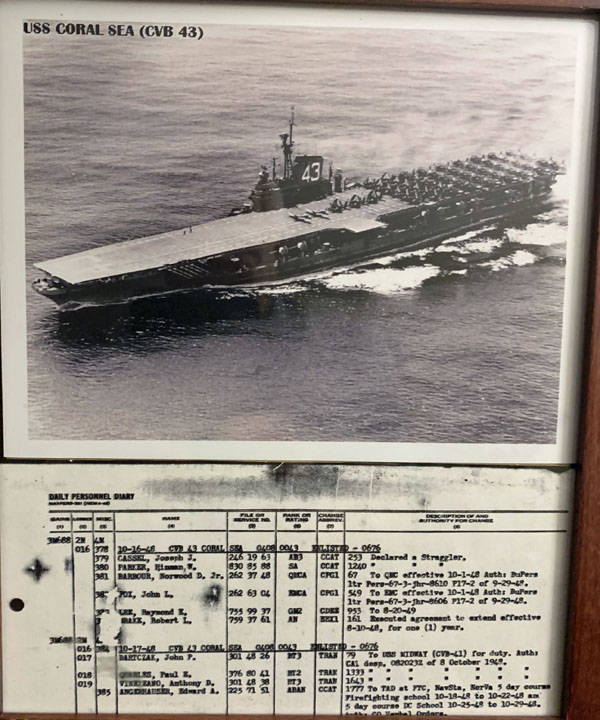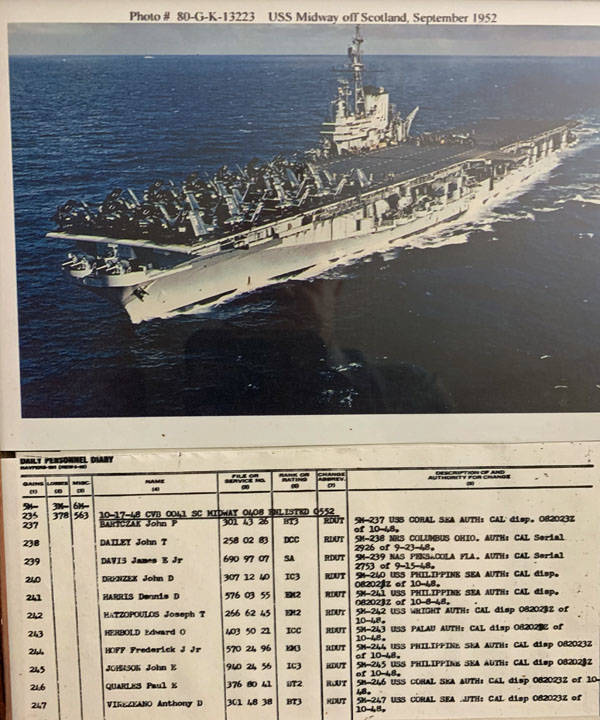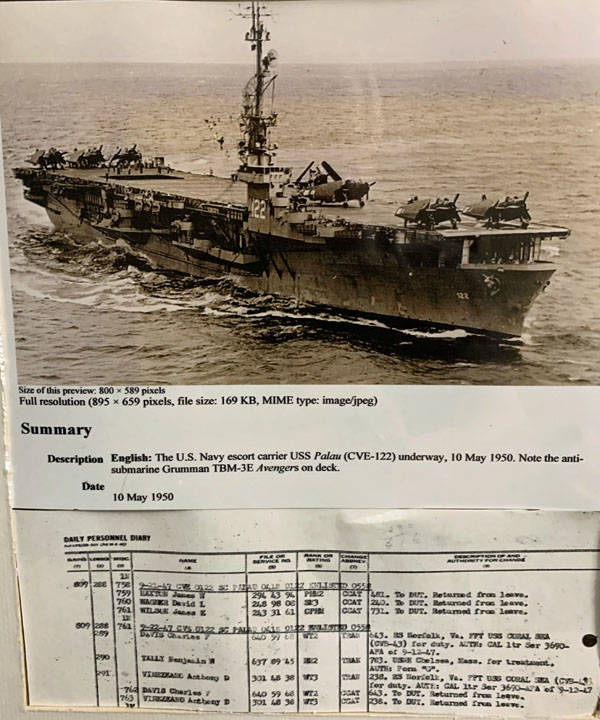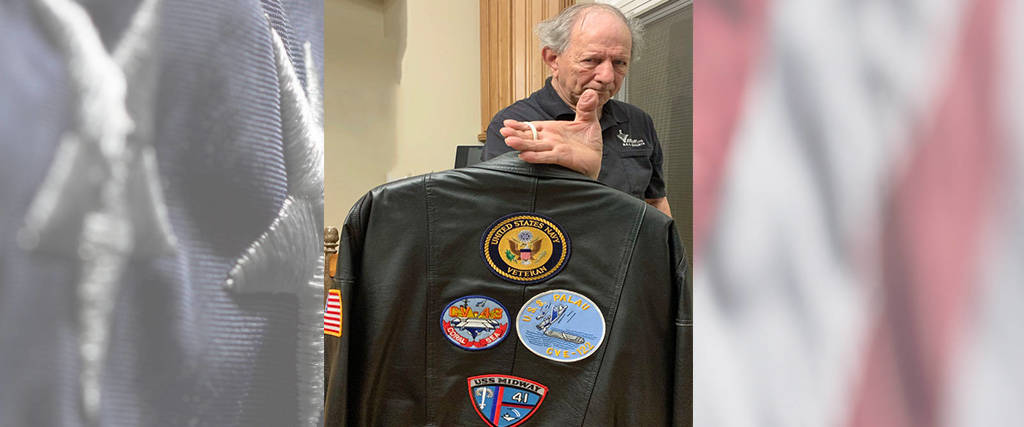U.S. Navy World War II Peotone, IL Flight date: October, 2019
By Frank Hauenschild, Honor Flight Chicago Veteran Interviews Volunteer
At the beginning of World War II, Anthony “Tony” Vinezeano was thirteen years old and was attending Hirsch High School in the Grand Crossing area of Chicago. Like many other teens in that era, Tony began working in a machine shop as a part-time apprentice in addition to attending high school. Being unabashedly honest, Tony admitted that he was not that interested in high school life and had to make a decision regarding his future, so he decided to enlist in the Navy and join the war effort. The only obstacle for enlistment facing Tony was his age – he was only 17-years-old when he made that decision. When asked how he was able to enlist in the Navy at seventeen, Tony, again being brutally honest, stated “I changed my birth certificate.” With that, Tony was off to Boot Camp at Great Lakes in August of 1945.
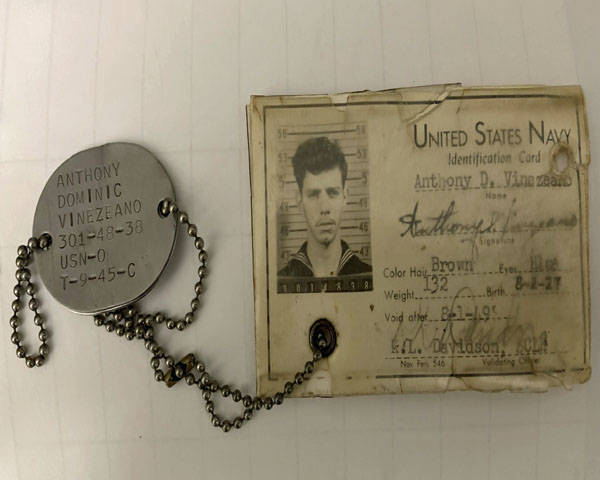
After completing Boot Camp and a short stint of guard duty at Great Lakes Naval Base, Tony was sent to Naval Station Bremerton, Washington, where he took a crash course in firefighting school and then was trained as a Boilerman for steam boilers. Tony’s first ship assignment was aboard the USS Palau (CVE-122). Tony related that the USS Palau was as escort carrier that was being deployed to the Bering Sea near the Aleutian Islands for patrol duty. After World War II ended, tensions were increasing between the United States and the Soviet Union. To that end, the USS Palau was sent to monitor the seas between the U.S. Alaskan Territory and the Soviet Union.
On the USS Palau, Tony maintained the oil-based boilers that not only converted sea saltwater to freshwater, but also powered the massive turbines which powered the ship. While at sea for three months at a time, the boiler man worked in shifts lasting no more than four hours due to the 125-degree heat in the boiler rooms. On that schedule, Tony said that he would work the boiler room, eat, sleep then go back on duty. He occasionally got a few moments on deck and was able to watch some of the many flight operations that were being conducted, but that was not often. “I spent most of my life below deck while in the Navy,” Tony recalled.
The Palau would encounter extremely rough seas and severe ice storms while at sea. During one ice storm, Tony vividly remembered that a Corsair fighter aircraft broke its mooring, went overboard and was lost. Though Tony was assigned to the boiler room, he did have some topside duty. “I had to climb to the top of the crow’s nest, more than three stories above the flight deck, and look down the smokestack to determine the color of the smoke.” The boiler man had to check the color of the smoke being emitted from the boilers; a heavy smoke trail would be a dead giveaway for the location of their ship. If the smoke was too dark, the boilermen below would adjust the air and oil mixture until the heavy smoke dissipated. Tony related that there was no easy way up to the top of the smokestack, and none of our current day safety features. Tony said he was never asked if he could make the climb for smokestack duty; it was only “get up there and report.” Being seventeen, and being “gung-ho,” Tony always completed his assignment.
It wasn’t all Bering Sea duty on the USS Palau. Tony recalled that the USS Palau eventually turned south and traveled through the Panama Canal. “It was much better than the three major storms we sailed through in the Bering Sea.” Navigating through the Panama Canal, the Palau ended up in Newport News, Virginia; Tony waited for his next ship assignment. As an aside, Tony did complete his GED while aboard the USS Palau!
Shortly after arriving in Newport News, Tony was assigned to the USS Coral Sea (CVB 43), a newly built Midway-class aircraft carrier which was commissioned on October 1, 1947. As a member of the original crew on the USS Coral Sea as a Boilerman, Tony was bestowed the honor of being a “Plank Owner” which entitled him to “One Clear and Unencumbered Title to One Plank” of the USS Coral Sea. They traveled to Florida where the Coral Sea received its first aircraft. From there, being a new ship, the Coral Sea toured the southern half of the Atlantic Ocean stopping at various ports along Eastern South America.
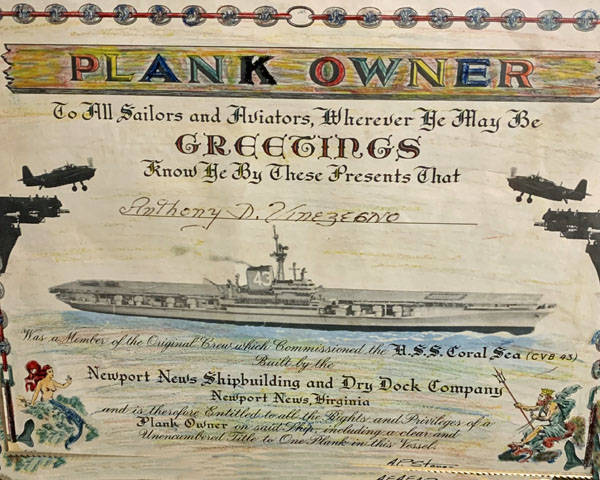
It was on the USS Coral Sea when Tony crossed the Equator, and in accordance with Navy tradition, he lost his designation as a “Pollywog.” Heading back north on the Atlantic Ocean, on the same tour of duty, he was a seasoned sailor and became a “Shellback” as it was his second passing of the Equator.
Returning to the States, the Coral Sea arrived at Norfolk, Virginia, where Tony received his first leave since joining the Navy. To travel around the Virginia area, he purchased his first car, a 1946 Pontiac. He enjoyed his time on dry land and driving to see the sights, but he had to park his prized possession when he was assigned to the USS Midway (CV-41) for his final tour of duty. Leaving Norfolk, the USS Midway crossed the Atlantic to Europe. Stopping at various ports in Europe, Tony received shore leave in the Algiers, Portugal, and France. One of the memorable stops in France was when Tony, and a handful of his shipmates, were invited to lunch at Adolph Hitler’s French chalet.
When asking Tony about life aboard the Midway, he related that it was vigorous work, with boiler room duty for eight hours then off for eight hours. When not in the boiler room, Tony was trained on the Quad 40’s, an anti-aircraft weapon which would be used against possible enemy aircraft. When asked about the alleged great food the Navy always had for their crew members, Tony just shrugged his shoulders and said, “Well, I didn’t gain any weight!” Tony recalled that he was able to see one of the first jet aircraft while on the Midway. He related that the Midway was outfitted with arresting cables while he was on board, but the catapults were not installed on carriers until later years, after he left the Navy. He did say that while on the Midway, he was able to visit many areas in Europe. The carrier was the flagship of the U.S. Navy carrier division and stopped at many various ports along the European coastline.
One of Tony’s favorite stops was in Italy. Being a direct descendant of Italian heritage, Tony was given leave to visit his grandmother in San Lucido, Italy. Traveling with a shipmate, Tony took a train to a village near San Lucido, where Tony was picked up by his cousins, Faust and Jacunda, in a horse drawn carriage and was transported to San Lucido. This was the first, and only time, that Tony was able to meet his grandmother. She was so proud of Tony, and for his service in the U.S. Navy, that she had to introduce him to everyone in the village. Following his family visit, Tony returned to the USS Midway for the trip back home.
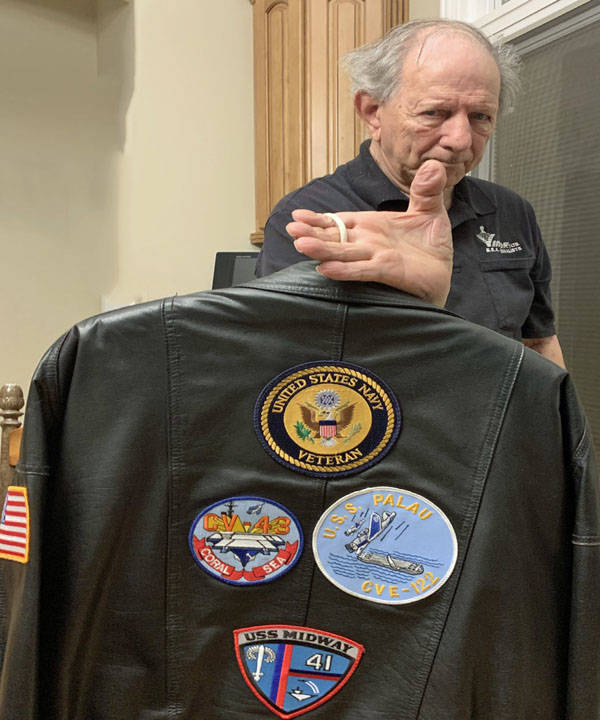
Upon arriving in Norfolk, Tony was discharged. After four years of being on various aircraft carriers with very little shore leave, Tony jumped in his ’46 Pontiac. Still wearing his uniform, he began his trip back to his hometown of Chicago. Unfortunately, while driving through the Blue Ridge Mountains, the Pontiac “threw a rod” which delayed his return home for a few days while his car was repaired. Arriving in Chicago in the evening, on Doty Avenue, Tony asked a couple of Chicago policemen for directions. Recognizing Tony was in uniform, they gave him an escort to 77th and Maryland, near his parents’ home.
Tony eventually returned to his job at American Tag Company and completed his apprenticeship as a tool and die machinist. While holding various jobs, Tony eventually landed at the Andrew Corporation as a mechanical engineer, designing and overseeing the building of satellite dishes and antennas. After a thirty-year career at Andrew, which included a five-year stint as a part-time police officer in Hometown, Illinois, Tony finally retired. Being 56 years old, and still enjoying life and work, he opened Vincor Corporation in Monee, Illinois. Vincor builds and installs satellite antennas worldwide and has placed their equipment in six of the seven continents in the world. To this day, at 91 years old, Tony goes to work every day as President of his family business.
Married to his wife, Jeanne, since 1950, Tony enjoys life at their home in Peotone, Illinois. Their family includes seven children: Mark, Michael, Laura, Paula, Fred, Carole and Robert, 20 grandchildren, 30 great-grandchildren and three great-great grandchildren.
